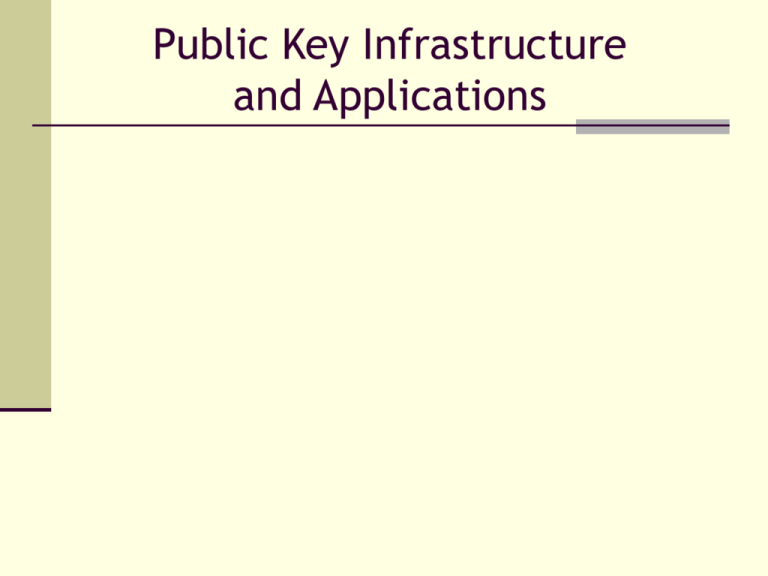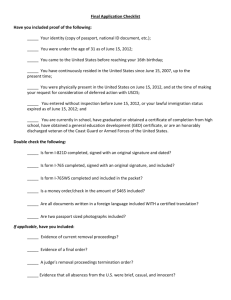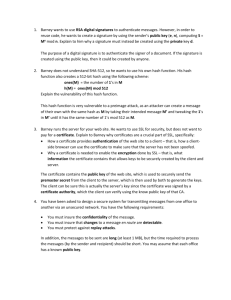Public Key Infrastructure
advertisement

Public Key Infrastructure
and Applications
Agenda
PKI Overview
Digital Signatures
What is it?
How does it work?
Digital Certificates
Public Key Infrastructure
PKI Components
Policies
Internet Security
Web Security with SSL
Smart Cards
Email signing – S/MIME
What’s the problem?
Information over the Internet is Free,
Available, Unencrypted, and Untrusted.
Not desirable for many Applications
Electronic Commerce
Software Products
Financial Services
Corporate Data
Healthcare
Subscriptions
Legal Information
Multiple Security Issues
Privacy
Authentication
Interception
Spoofing
Integrity
Non-repudiation
Modification
Proof of parties involved
Security Algorithms
Symmetric Algorithms
Triple-DES, DES, CAST, RC2, IDEA
Public Key Algorithms
RSA, DSA, Diffie-Hellman, Elliptic Curve
Hashing Algorithms
SHA-1, MD5, RIPEMD
Symmetric Key Encryption
If any one’s key is compromised, all keys
need to be replaced
Not practical or cost effective for Internet
environments
INTERNET
Public Key Cryptography
Public-Key Cryptography is an encryption scheme
that uses mathematically related, but not
identical keys.
Each user has a key pair (public key/private key).
Public
Encryption
Private
Decryption
Information encrypted with the public key can
only be decrypted using the private key.
What is a Digital Signature ?
A Digital Signature is the result of encrypting the
Hash of the data to be exchanged.
A Hash (or Message Digest) is the process of
mathematically reducing a data stream down to a
fixed length field.
The Hash uniquely represents the original data.
The probability of producing the same Hash with
two sets of different data is <.001%.
Signature Process is opposite to Encryption Process
Private Key is used to Sign (encrypt) Data
Public Key is used to verify (decrypt) Signature
Digital Signature Process
Step 1.
Step 2.
Hash
Encrypt
Data
Digital Signature
Hash
Private
Digital Signature
Step 3.
Public
Step 1. Hash (digest) the data using one of the
supported Hashing algorithms, e.g., MD2, MD5, or
SHA-1.
Step 2. Encrypt the hashed data using the sender’s
private key.
Step 3. Append the signature (and a copy of the
sender’s public key) to the end of the data that was
signed.
Signature Verification Process
Step 1.
Hash
Hash
Step 3.
Data
Step 2.
Decrypt
Hash
Digital Signature
Public Key
Step 1. Hash the original data using the same hashing
algorithm.
Step 2. Decrypt the digital signature using the sender’s
public key. All digital signatures contain a copy of the
signer’s public key.
Step 3. Compare the results of the hashing and the
decryption. If the values match then the signature is
verified. If the values do not match, then the data or
signature was probably modified in transit.
The Critical Questions
How can the recipient know with certainty
the sender’s public key? (to validate a
digital signature)
How can the sender know with certainty
the recipient’s public key? (to send an
encrypted message)
Digital Certificates
Before two parties exchange data using
Public Key cryptography, each wants to be
sure that the other party is authenticated
~~~~
~~~~
~~~~
Digital
Signature
Before B accepts a message with A’s Digital Signature,
B wants to be sure that the public key belongs to A
and not to someone masquerading as A on an open
network
One way to be sure, is to use a trusted third party to
authenticate that the public key belongs to A. Such a
party is known as a Certification Authority (CA)
Once A has provided proof of identity, the
Certification Authority creates a message containing
A’s name and public key. This message is known as a
Digital Certificate.
Digital Certificates
A Digital Certificate is simply an X.509 defined data
structure with a Digital Signature. The data
represents who owns the certificate, who signed the
certificate, and other relevant information
X.509 Certificate
Version #
Serial #
Signature Algorithm
Issuer Name
Validity Period
Subject Name
Subject Public Key
Issuer Unique ID
Subject Unique ID
Extensions
Digital Signature
When the signature is generated
by a Certification Authority
(CA), the signature can be
viewed as trusted.
Since the data is signed, it can
not be altered without
detection.
Extensions can be used to tailor
certificates to meet the needs
of end applications.
Certificate Life Cycle
Key pair generated
Certificate issued
Re-certify
New key
pair
generated
Key pair in use
Private key
compromised
Certificate expires
Certificate
revoked
Key pair lifetime exceeded?
Certificate Revocation Lists
CA periodically publishes a data structure
called a certificate revocation list (CRL).
Described in X.509 standard.
Each revoked certificate is identified in a
CRL by its serial number.
CRL might be distributed by posting at
known Web URL or from CA’s own X.500
directory entry.
PKI Players
Registration Authority (RA) to identity proof
users
Certification Authorities (CA) to issue
certificates and CRL’s
Repositories (publicly available databases)
to hold certificates and CRLs
Certification Authority (CA)
Certification Authority
What’s Important
Trusted (Third) Party
Operational Experience
Enrolls and Validates
High Assurance Security
Architecture
Subscribers
Issues and Manages
Certificates
Manages Revocation and
Renewal of Certificates
Establishes Policies &
Scalability
Flexibility
Interoperability
Trustworthiness
Procedures
Certification Authority = Basis of Trust
Registration Authority (RA)
Enrolling, de-enrolling, and approving or
rejecting requested changes to the certificate
attributes of subscribers.
Validating certificate applications.
Authorizing requests for key-pair or certificate
generation and requests for the recovery of
backed-up keys.
Accepting and authorizing requests for
certificate revocation or suspension.
Physically distributing personal tokens to and
recovering obsolete tokens from people
authorized to hold and use them.
Certificate Policy (CP) is …
the basis for trust between unrelated
entities
not a formal “contract” (but implied)
a framework that both informs and
constrains a PKI implementation
a statement of what a certificate means
a set of rules for certificate holders
a way of giving advice to Relying Parties
Public Key Technology
NON-REPUDIATION
INTEGRITY
AUTHENTICATION
PRIVACY
Public Key Security
Services
Technology
Digital Certificates
Certification Authorities
Infrastructure
Security Management
Public Key Technology Best Suited to Solve Business Needs
Infrastructure = Certification Authorities
Authentication/Access Control
Can Public Key Technology be
used to perform Authentication
and Access Control?
Sure Can
How?
Digital
Signature
Using Digital Signatures
and Digital Certificates
SSL Protocol
Secure Socket Layer (SSL) is a Network
Layer protocol used to secure data on
TCP/IP networks.
HTTP
FTP
NNTP
and so on …..
Secure Socket Layer
TCP/IP Layer
Application
Network Layer
SSL 2.0 Protocol
SSL 2.0 provides encryption between the server
and the browser.
• Browser
Connects to
Secure Server
• Browser verifies
signature on CertS
• Browser generates
session key
(SessKeyB)
• Browser encrypts
SessKeyB using CertS
CertS
{SessKeyB } CertS
{Data} SessKeyB
• Server sends copy of
Server certificate (CertS) to
Browser, indicating that
SSL 2.0 is enabled
• Server decrypts
SessKeyB using it’s
private key
• Browser and Server use SessKeyB to encrypt all data exchanged over the Internet
SSL 3.0 with Client Authentication
• Browser Connects to
Secure Server
CertS - SSL 3.0
• Browser verifies
signature on CertS
• Browser generates
session key (SessKeyB)
• Browser encrypts
SessKeyB using CertS
• Browser asks operator to
select a Browser
certificate (CertB) to
access server
{SessKeyB } CertS + CertB
{Data} SessKeyB
• Server sends copy of Server
certificate (CertS) to Browser,
indicating that SSL 3.0 is enabled
with client authentication
• Server verifies signature on
CertB (Server can check other
information as well)
• Server decrypts SessKeyB
using it’s private key
• Browser and Server use SessKeyB to encrypt all data exchanged over the Internet
Smart Cards
Microprocessor with memory that can generate and
store keys and certificates
Different form factors and interface mechanisms
Cryptographic functions using private key are
processed on the card itself
Smart Cards and PKI
Smart cards are «certificate wallets»
Secure storage for:
Owner private key
Smart Cards are a «PC-in-your-Pocket»
Generation of owner’s digital signature
Smart cards provide:
Mobility
Security
Transparency
Digital ID
Asymmetric key-pair
public key
private key
X.509 certificate
ISO standard
public key
credentials
Smart card application example:
Digital Signature
Smart card in
heterogeneous environments
Smart cards need readers and drivers
Readers
desktop or embedded (keyboard, floppy slot)
optional display and keypad
PC world ready for installation
Mac, Unix & Linux ‘waiting’ for USB
Drivers
PC/SC standard for Windows PC
custom developments
Pay-TV, did you know it’s PKI ?
Pay-TV systems installed worldwide
22 millions customers
pay-per-view
electronic purse
Internet
Managed and secured with a very high
proprietary secured PKI solution
based on a smartcard
Signed and Encrypted Email – S/MIME
S/MIME – Secure Multipurpose Internet Mail
Extensions
Prevent email spoofing
Helps preventing forged email
Helps preventing spam
Protect sensitive messages & documents
Secure business processes
Signed messages
S/MIME-based applications
Using PKI Certificates in Outlook (1)
1
Open Outlook.
Select Tools
from the main
menu then
choose Options
from the dropdown menu.
Using PKI Certificates in Outlook (2)
2
Click on the
Security tab.
Using PKI Certificates in Outlook (3)
3
Click the
Settings
button.
Using PKI Certificates in Outlook (4)
4
In the Security
Settings Name field,
enter a name for the
new Security Setting .
Type S/MIME in the
Secure Message
Format field.
Click the Choose button
next to the Signing
Certificate field.
Using PKI Certificates in Outlook (5)
5
Click on the
certificate issued
by C3 Mail CA.
This is your Email
Signing certificate.
Click OK.
Using PKI Certificates in Outlook (6)
6
Choose SHA1 from
the Hash Algorithm
drop down menu.
Click on the Choose
button next to the
Encryption
Certificate field.
Using PKI Certificates in Outlook (7)
7
Click on the certificate
issued by C3 Mail CA.
This is your Email
Encryption certificate.
Click OK.
Using PKI Certificates in Outlook (8)
8
Choose 3DES from
the Encryption
Certificate drop
down box.
Check all 3 boxes in
the Change Security
Settings window.
Click OK.
Using PKI Certificates in Outlook (9)
9
Click the
Apply button
then click OK.
Questions?







